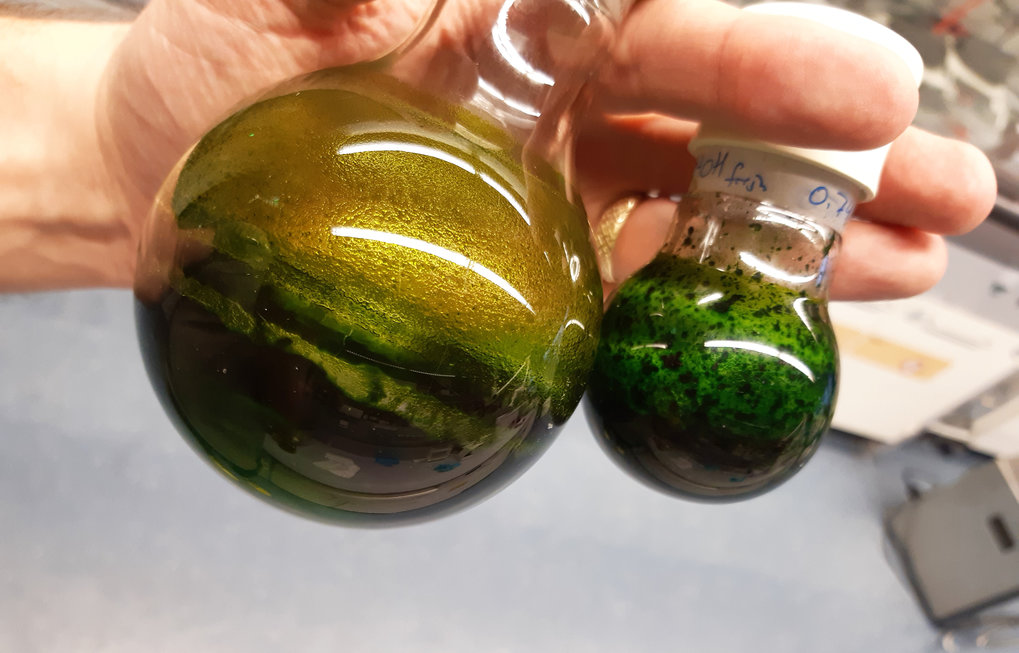1040 Publications Relating to Effects of Artemisinin and its Analogs on Cancer (April), 2024
null1040 Studien
Effects Artemisinin on Cancer - 1040 items
Search results on Artemisia annua and infections thru viruses and bacterias
Items: 1 to 20 of 1558
Antitumor Activity of Artemisinin and Its Derivatives: From a Well-Known Antimalarial Agent to a Potential Anticancer Drug
Intra-Lesional Injection of the Novel PKC Activator EBC-46 Rapidly Ablates Tumors in Mouse Models
Intra-Lesional Injection of the Novel PKC Activator EBC-46 Rapidly Ablates Tumors in Mouse ModelsLöslichkeit von Artemisinin in Wasser
Abstract
The solubility of artemisinin in ethanol + water was measured at several concentrations and over the temperature range of (278.2 to 343.2) K. The solubility of artemisinin in ethanol and water mixture increases with the increase in temperature and with ethanol concentration. The solubility data were correlated with a modified Apelblat equation.
Experimental design for extraction of artemisinin from Artemisia annua and validation of the assay method
Graphical abstract

Solubility of Artemisinin in Seven Different Pure Solvents
How to explain the high solubility of artemisinin in Artemisia annua infusions?
A review paper published by Frank van der Kooy in 2013 (Journal of Ethnopharmacology, 150, 1-13) revived our interest in the question why the solubility of artemisinin is higher in Artemisia annua infusions than for the pure substance in distilled water.
Anticancer Properties of Distinct Antimalarial Drug Classes
Abstract
We have tested five distinct classes of established and experimental antimalarial drugs for their anticancer potential, using a panel of 91 human cancer lines. Three classes of drugs: artemisinins, synthetic peroxides and DHFR (dihydrofolate reductase) inhibitors effected potent inhibition of proliferation with IC50s in the nM- low µM range, whereas a DHODH (dihydroorotate dehydrogenase) and a putative kinase inhibitor displayed no activity. Furthermore, significant synergies were identified with erlotinib, imatinib, cisplatin, dasatinib and vincristine. Cluster analysis of the antimalarials based on their differential inhibition of the various cancer lines clearly segregated the synthetic peroxides OZ277 and OZ439 from the artemisinin cluster that included artesunate, dihydroartemisinin and artemisone, and from the DHFR inhibitors pyrimethamine and P218 (a parasite DHFR inhibitor), emphasizing their shared mode of action. In order to further understand the basis of the selectivity of these compounds against different cancers, microarray-based gene expression data for 85 of the used cell lines were generated. For each compound, distinct sets of genes were identified whose expression significantly correlated with compound sensitivity. Several of the antimalarials tested in this study have well-established and excellent safety profiles with a plasma exposure, when conservatively used in malaria, that is well above the IC50s that we identified in this study. Given their unique mode of action and potential for unique synergies with established anticancer drugs, our results provide a strong basis to further explore the potential application of these compounds in cancer in pre-clinical or and clinical settings.
Artemisia annua to be tested against COVID-19
Artemisia annua extracts:
 The Max Planck Institute of Colloids and
Interfaces, Potsdam (Germany) will collaborate with ArtemiLife Inc., a
US based company and medical researchers in Denmark and Germany to test
Artemisia annua plant extract and artemisinin derivatives in laboratory
cell studies against the novel coronavirus disease (COVID-19). April 08, 2020
The Max Planck Institute of Colloids and
Interfaces, Potsdam (Germany) will collaborate with ArtemiLife Inc., a
US based company and medical researchers in Denmark and Germany to test
Artemisia annua plant extract and artemisinin derivatives in laboratory
cell studies against the novel coronavirus disease (COVID-19). April 08, 2020"I am excited about the international collaboration of academic and private sector scientists to conduct cell study testing of Artemisia annua against coronavirus.” said Professor Peter H. Seeberger, Director at the Max Planck Institute of Colloids and Interfaces in Potsdam.
COVID-19 is caused by severe acute respiratory syndrome coronavirus-2 (SARS-CoV-2), a positive-sense single-stranded RNA virus that is contagious in humans. Like the SARS-related coronavirus strain implicated in the early 2000’s SARS outbreak, SARS-CoV-2 is a member of the same subgenus. SARS-CoV-2 is unique among known beta-coronaviruses in its incorporation of a polybasic cleavage site, a characteristic known to increase pathogenicity and transmissibility in other viruses.
“Given the similarities between those two viruses, plant extracts and artemisinin derivatives need to be tested against the new coronavirus and this international collaboration makes it possible,” continued Prof. Seeberger.
 The cell study testing will be conducted in research institutions in
Denmark and Germany with the plant extract from Artemisia annua and pure
derivatives isolated from the plant such as artemisinin. Treatments
containing an artemisinin derivative, artemisinin-based combination
therapies (ACTs), are now standard treatments worldwide for malaria.
Artemisia annua extracts show very little toxicity and artemisinin-based
drugs are widely used to treat malaria even in newborns.
The cell study testing will be conducted in research institutions in
Denmark and Germany with the plant extract from Artemisia annua and pure
derivatives isolated from the plant such as artemisinin. Treatments
containing an artemisinin derivative, artemisinin-based combination
therapies (ACTs), are now standard treatments worldwide for malaria.
Artemisia annua extracts show very little toxicity and artemisinin-based
drugs are widely used to treat malaria even in newborns.Max Planck Institute for Colloids and Interfaces
The Max Planck Institute of Colloids and Interfaces was founded in 1992 and is divided into four departments (Biomaterials, Biomolecular Systems, Colloid Chemistry, Theory & Bio-Systems). Current research topics include polymeric films, membranes, organic and inorganic nanostructures, microcapsules, biomineralization, nano- and microreactors, molecular motors and filaments, and the chemistry and biology of carbohydrates. The Biomolecular Systems Department has been studying, inter alia, the production and use of artemisinin and its derivatives for almost a decade.
https://www.mpikg.mpg.de/en
ArtemiLife Inc.
ArtemiLife Inc. is developing and planning to commercialize Artemisia annua-based products. ArtemiLife Inc. blends cutting edge science with pesticide-free growing and US-based production techniques, ArtemiLife Inc. is launching a range of teas and coffees supplemented with Artemisia annua.
https://artemilife.com/




